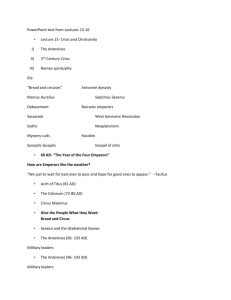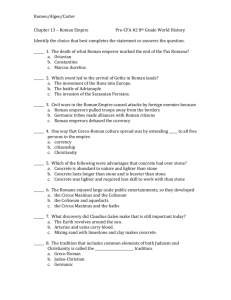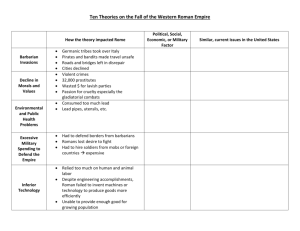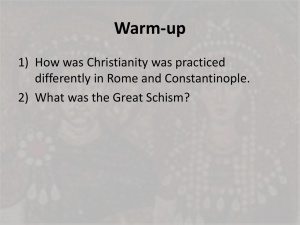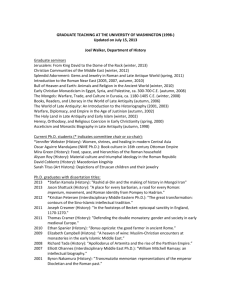PP text from L 7
advertisement
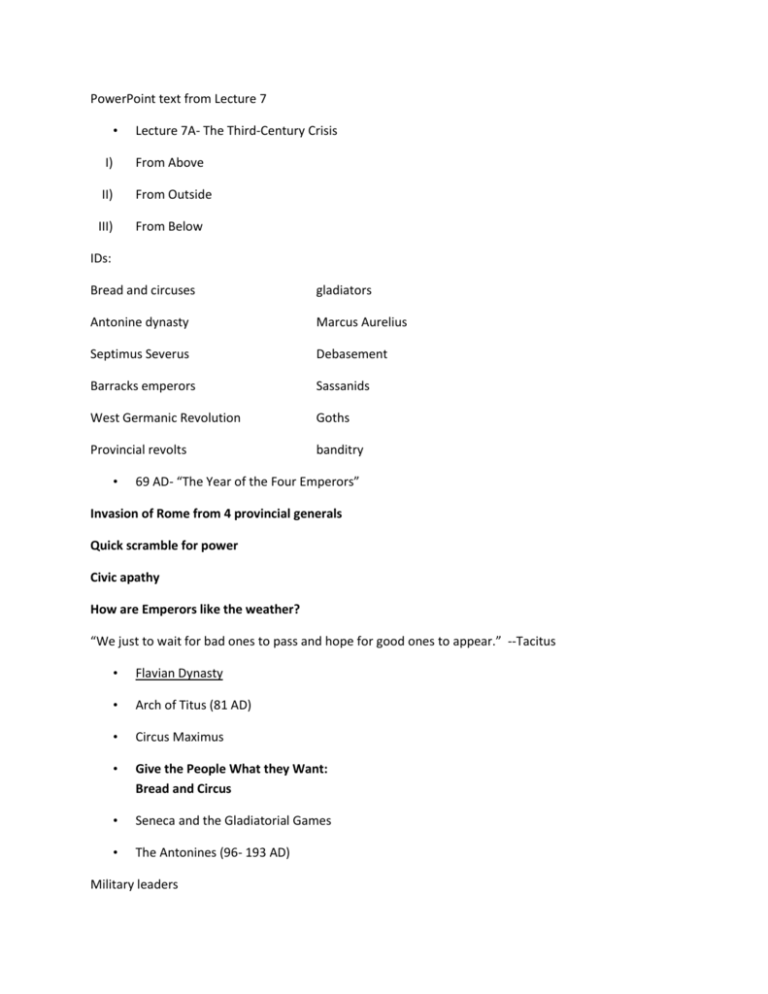
PowerPoint text from Lecture 7 • Lecture 7A- The Third-Century Crisis I) From Above II) From Outside III) From Below IDs: Bread and circuses gladiators Antonine dynasty Marcus Aurelius Septimus Severus Debasement Barracks emperors Sassanids West Germanic Revolution Goths Provincial revolts banditry • 69 AD- “The Year of the Four Emperors” Invasion of Rome from 4 provincial generals Quick scramble for power Civic apathy How are Emperors like the weather? “We just to wait for bad ones to pass and hope for good ones to appear.” --Tacitus • Flavian Dynasty • Arch of Titus (81 AD) • Circus Maximus • Give the People What they Want: Bread and Circus • Seneca and the Gladiatorial Games • The Antonines (96- 193 AD) Military leaders • The Antonines (96- 193 AD) Military leaders Tradition of succession Ended with Marcus Aurelius Commodus - overthrown • I) From above • The Third-Century Crisis Problems: From Above • Pertinax Successor to Commodus Appointed by Praetorian Guard Career soldier Killed by Praetorian Guard after 3 months • Emperor Septimus Severus (r. 193-211) Pertinax succeeds Commodus - killed by Praetorian Guard Declining plunder Confiscations from Senators Military rule “Enrich the army, boys, and scorn the rest.” • Caracalla (r. 211-217) and debasement • “Barracks emperors” Praetorian Guard Financial problems “Raised and destroyed”: 17 of the 20 emperors between 235 and 284 AD are killed by their own troops or other Romans • The Third-Century Crisis Problems: From Above From Outside • Problems from outside the Empire Slowing conquest Famine Plagues New barbarian threats • Sassanid Empire The Sassanids: Revived Persian Empire After 227 AD Capture of Valerian • West Germanic Revolution Initial clans New alliances Germans: Franks Alemanni Marco-manni Goths: Germans Slavs Scythians • The Third-Century Crisis Problems: From Above From Outside From Below • III) From Below • Debasement and inflation • Bulla the Lucky Army of 600 men Northern Italy “Carry this message back to your own masters: Let them feed their slaves so that they might not be compelled to turn to a life of banditry.” • Lecture 7B- Roman Spirituality I) Religion and consolation II) Early Christianity, 30AD- 200AD III) The Great Persecution IDs: Persecution neoplatonism Asceticism Mystery cults Synoptic Gospels John’s Gospel Christology Revelations Crucifixion Saul of Tarsus Ecclesiae Social mission Martyrs Diocletian Tetrarchy • Great Persecution Imperial Response: Persecution Initial explanation of problems: Roman gods were upset - resistance from monotheists Answer: enforce religious conformity • Neoplatonism Founded by Plotinus (c. 204-270 AD) Three teachings: 1) Emanations -soul -matter 2) Mysticism - reunion 3) Asceticism - Denial of materialism • Roman “Mystery Cults” From fringes to the center: Isis Mithras Dionysius Personal alternative to civic religion • Jewish-Roman relations Various reactions to Roman rule: Compromise: Sadducees Hard-liners: Hasidim Pharisees Zealots (Galilee) • Early Christianity: “The Historical Jesus” No direct texts- Greek-language records, 50-150 AD Sources: Large numbers- about 50 gospels, 21 epistles Gospels: Synoptic books: Matthew, Mark, Luke Book of John Acts and Epistles Revelations • Post-Crucifixion Christianity (after 30 AD) Resurrection Peter Jewish context New elements Baptism Eucharist • Saul (Paul) of Tarsus (c.10-c.63 AD) Observant Jew Also a Roman citizen Universal mission Debate within early Church (Acts of the Apostles, Chapter 15) • Spread of Christianity before 200 AD Ecclesiae Trading cities <10,000 by 100 AD 200,000 by 200 AD But only .3% of total imperial population (60 million) • Social Mission of Christianity • II) Persecution • Roman Persecutions of Christians Reaction to early problems - ex. Nero Monotheism as unpatriotic “Atheism,” etc. Sporadic Intensifies during the 3rd-Century Crisis • Saint Perpetua’s martyrdom (203 AD) Now dawned the day of their victory, and they went forth from the prison into the amphitheatre as it were into heaven, cheerful and bright of countenance; if they trembled at all, it was for joy, not for fear. Perpetua followed behind, glorious of presence, as a true spouse of Christ and darling of God; at whose piercing look all cast down their eyes. . . . For she said: For this cause came we willingly unto this, that our liberty might not be obscured. For this cause have we devoted our lives, that we might do no such thing as this; this we agreed with you. . . . Perpetua began to sing, as already treading on the Egyptian's head. Revocatus and Saturninus and Saturus threatened the people as they gazed. Then when they came into [Governor] Hilarian's sight, they began to say to Hilarian, stretching forth their hands and nodding their heads: You judge us, they said, and God you. . . . Then truly they gave thanks because they had received somewhat of the sufferings of the Lord. • Christianity and Suffering • Two Major policies of Diocletian (r. 284-305) Overextended empire 1) Tetrarchy: East and West sections Augustus- senior Caesar- junior Dominus 2) “Great Persecution” • III) Imperial Conversion • Constantine (r. 306-337) Successor to Diocletian Internal fighting Battle of Milvian Bridge Vision • Constantine (r. 306-337) Victory at Milvian Bridge Edict of Milan (313 AD) • Constantine’s conversion (?) • Church and Empire Imperial orders vs. paganism Rapid growth in 4th Century- from 4 million to 30 million Continuing conflicts: 390 ADEmperor Theodosius and St. Ambrose of Milan • I) Lecture 7C: Early Christianity Structure IDs: Bishops dioceses Arianism • Church Structure and Doctrine Conspiracy? Gnostic Gospels Church Councils • Expansion of Christianity after 300 AD Rapid growth 4m- 300 AD 30m- 400 AD Chiliasts Dioceses Leadership- bishops Doctrine- orthodoxy • Roman Dioceses 330 AD • Major Patriarchates Jerusalem Antioch Alexandria Constantinople Rome (Petrine Succession)
